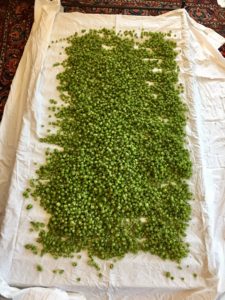In this post we outline three steps to help you convert a chest freezer into a keezer (a chest freezer for kegs).
Step One: get your hands on a chest freezer
All keezers begin their life as a standard chest freezer.
The most important thing to consider before buying your chest freezer is to determine how many kegs you will want to have on hand at one time. We recommend a minimum of 2 kegs as this will allow one to carbonate while the other is dispensing, allowing for an uninterrupted stock of carbonated beer or cider once the first keg runs dry. The number of kegs you want capacity for will determine the size of chest freezer you need.
In addition to space for kegs the chest freezer should also have space for a Co2 tank. Every chest freezer has a small section of floor that is elevated to make space for a compressor. This elevated section of chest freezer floor is typically too shallow to hold an additional keg but works very well as a place to hold a Co2 tank. It is important to make sure the keezer, once fully built with the added depth that a collar provides, will have enough height for the Co2 tank which will be taller than the kegs when it is resting on the elevated part of the chest freezer floor.
A standard 5 gallon home-brew keg measures 9″ in diameter and 25″ in height. You will need about 20″ of height for a Co2 tank and regulator.
Step 2: build and install a collar
The collar of a keezer is a wooden frame that is placed on top of the chest freezer. The collar adds additional height to accommodate kegs, a Co2 tank and provides a place to drill through to install your faucets. We think the best looking collars incorporate 2 pieces of wood, one on the inside that supports the chest freezer lid and longer one on the outside that provides a clean aesthetic by hiding the inside piece of wood. For our keezer we used vertical grain douglas fir; 5/4×6 on the inside and a 1×8″ on the outside.
A longer outside piece of wood provides the illusion that the collar is levitating on top of the chest freezer and an gives overall cleaner look compared to having the inner collar exposed from the outside.

Notches should be made onto the outer collar to allow the chest freezer door handles to attach to the inner collar. Without these notches the door would not align with the frame as the outer collar is wider than the chest freezer.

Miter joints provide a clean look but can be a challenge to cut properly without some past carpentry experience (I’ll be the first to admit that I found help to cut these corners…). Alternatively, a butt joint can look just as slick with a bit of sanding and will be a whole lot easier to cut.

The collar should be installed onto the chest freezer with silicon to provide an airtight but not permanent seal.
Step 3: install your hardware
Faucets
Drill holes through the collar with a 7/8“ drill bit to provide a place to pass your shanks through.
Temperature Controller
A temperature controller allows you to control the temperature of the chest freezer, periodically turning the freezer on and off to maintain a set temperature. Without a temperature controller you would end up with 5 gallons of ice in your keg!
Find a place on the exterior of your chest freezer to mount the temperature controller and drill a small hole through the collar directly above the mounted temperature controller. Pass the sensor through this hole.




